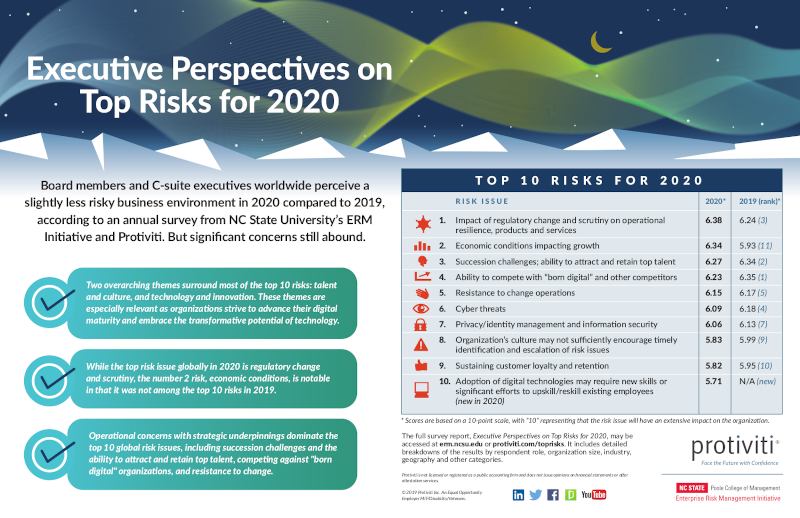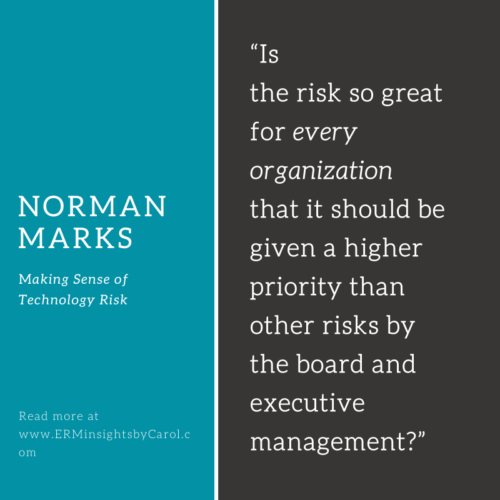As we enter a new year (…and a new decade), it’s always a good idea to take a step back to see what may impact organizations in the year ahead.
Every fall, NC State’s ERM Initiative, in partnership with Protiviti, surveys C-suite executives and Boards across a variety of industries to gauge what they see as the biggest risks likely to affect their organization over the next year. This year’s survey had 1,063 respondents from both private and public entities throughout the world – the highest number of participants in the survey’s 8 year history.
The survey includes 30 specific risks grouped across 3 categories – macroeconomic, strategic, and operational.
Participants were asked to rate the potential impact of each of these individual risks on a 10-point scale. An average is then taken and the 10 risks with the highest score make the final list.
(Click here to view the full report and other resources.)
In an interview on the report, Jim DeLoach of Protiviti and Dr. Mark Beasley of NC State draw out two key themes to this year’s top risks. These include:
- Talent & Culture – This theme includes risks around succession planning and whether the organization’s personnel have the right talent and skills to take advantage of new technology. On the culture side, resistance to change and timely identification and elevation of risk issues remain a top concern of company leaders.
- Technology & Innovation – This theme includes risks to the organization’s ability to embrace, manage, and harness technology to remain competitive, along with concerns about privacy and information security. Many executives are concerned about competing with newer “born digital” firms. Topping the list at #1 is the concern about how regulatory change and scrutiny will impact the organization’s ability to innovate and compete.
When examining these two general themes, it becomes clear how interconnected they are. While many of the risks on the top 10 list are operational in nature, they do have strategic underpinnings. As DeLoach explains:
Combined inability to attract and retain the right talent and ensure the appropriate culture may negatively affect the organization’s ability to execute increasingly complex strategies.
One other interesting result from this year’s survey is how economic concerns shot from #11 in 2019 to #2 in this year’s report. Last year was in fact an anomaly – in the early years of this report, economic concerns were always in the top 10. However, increased uncertainty around Brexit, trade wars, and the record stock market are making executives a bit more cautious in how they make strategic investments as compared to a year ago.
Reports like this and others can be useful for starting a discussion, but they are also very risk-centric…
At the conclusion of this brief podcast introducing the report, Dr. Beasley explains that while the top 10 risks will not apply to all organizations, it provides a benchmark executives can compare their risk management activities against – to be a “completeness check” according to feedback on the report.
While I agree with Dr. Beasley to an extent, reports like the one he spearheads, or the just released Global Risks Report 2020 from the World Economic Forum, are still very risk-centric in my opinion.
NC State’s report does a good job of describing how these risks can impact strategic objectives, but there is little to no discussion about opportunities and performance from what I can see.
As I discuss here, and thought leaders like Hans Læssøe, Norman Marks, and others emphasize, ERM shouldn’t just be a tool for minimizing risks and preventing failure, but also ensuring success through intelligent, informed decisions.
A short section from Norman Marks’ latest book, Making Business Sense of Technology Risk, provides a good illustration.
As the NC State and other reports on top risk demonstrate, cybersecurity and the risk of data breaches is top of mind for many, possibly due to alarmist rhetoric from media outlets, consultants, and others. Norman sums it up:
But is the risk so great for every organization [emphasis added] that it should be given a higher priority than other risks by the board and executive management?
Should they be investing scarce funds [emphasis added] in cyber risk management, or in new and disruptive technology, product development, sales capability, manufacturing capacity, and so on?
Therefore, just because a risk appears on a top 10 list or is discussed incessantly in the media and elsewhere doesn’t mean you automatically need commit huge amount of resources combating it. As Norman illustrates in his book, doing so could in fact be even more destructive.
What risk practitioners and executive leadership have to ask when reviewing generalized top risk reports – do any of these apply to us and how will they impact the achievement of our objectives? Or as Tim Leech and others expound, start with your goals in mind and identify risks to achieving these goals.
While a risk-centric approach will do a good job of minimizing threats, this is not how companies succeed in today’s fast-paced world.
Does your organization use lists like this to guide risk management activities or simply as a jumping off point?
These lists are certainly useful for understanding the macro-level picture of threats facing companies in the world today.
Don’t be shy! I’m always interested in learning what my fellow risk practitioners are thinking. To share your thoughts, leave a comment below or join the conversation on LinkedIn.
And if you are seeking to better understand how risks like this will impact the success of your organization, contact me to discuss your specific situation today!
Featured image courtesy of Charles Forerunner via Unsplash.com










